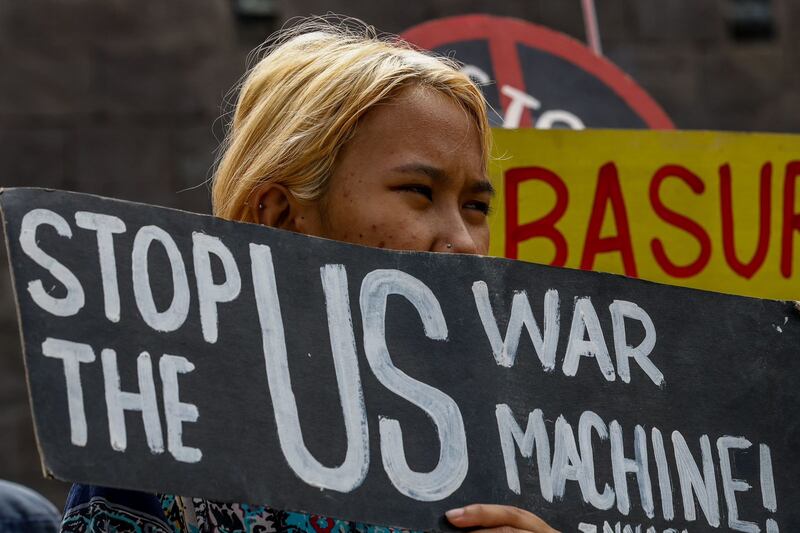The United States on Tuesday announced an “unprecedented” $500 million infusion to help the Philippines defend its shores amid increasing territorial threats from China, as the American and Filipino defense and diplomatic chiefs met in Manila.
U.S. Defense Secretary Lloyd Austin and Secretary of State Antony Blinken made the announcement after meeting with their Filipino counterparts, Gilbert Teodoro and Enrique Manalo, at a so-called "2+2" meeting in the Philippine capital. It was the first time the meeting was held in the Southeast Asian country, a key U.S. ally in the region that has opened nine military bases to American troops.
“[W]e are taking bold steps to strengthen our alliance,” Austin told a press briefing after nearly four hours of closed-door talks.
“We are poised to deliver a once-in-a-generation investment to help modernize the Armed Forces of the Philippines and the Philippine Coast Guard. We are working with the U.S. Congress to allocate 500 million dollars in foreign military financing into the Philippines,” he said.
The Pentagon chief described this level of funding as "unprecedented," saying "it sends a clear message of support for the Philippines from the Biden administration, the U.S. Congress and the American people."
Separately, the U.S. was looking to double its investment in Philippine military sites where American troops have access to under the Enhanced Defense Cooperation Agreement, Austin said.
“President Biden’s budget request this year includes more than 128 million dollars to fund important EDCA infrastructure projects and U.S. government investment in these locations,” he said.
“During our meeting we also reaffirmed that the Mutual Defense Treaty remains the bedrock of our alliance,” Austin said. “And let me be clear: the Mutual Defense Treaty applies to armed attacks on either of our armed forces, aircraft or public vessels anywhere in the South China Sea.”
Signed in 1951, the treaty calls on the allies to come to each other’s aid in times of foreign aggression.
The Philippines maintains an old, rusting World War II-era ship, the BRP Sierra Madre, in Second Thomas (Ayungin) Shoal, to serve as its military outpost in the disputed South China Sea reef.
Marcos meets with Austin, Blinken
President Ferdinand Marcos Jr. set the tone for Tuesday’s 2+2 meeting when he met Austin and Blinken at the Malacañang presidential palace earlier in the day. He said he was pleasantly surprised that both secretaries had taken time out to visit Manila despite the political transition in the U.S.
“And I am always happy that these communication lines remain very open – all the things we are doing together in terms of alliance, in terms of the specific context of our situation here in the West Philippine Sea … are constantly examined and re-examined so we are agile in terms of our responses,” Marcos said, referring to South China Sea waters within the Philippines’ exclusive economic zone.

Blinken said the meeting was evidence of a “steady drumbeat of very high-level engagements” between the longtime allies.
Austin underscored that both nations were “more than allies” and practically family.
“We have common interests, common values,” he told Marcos, according to transcripts released by the presidential palace. “And so I think we’ve done a lot over the last three and a half years to continue to strengthen our alliance, and we look forward to continuing to work with you and your team to move even further.”
Last week, the Philippines and China agreed on an arrangement on Filipino missions to Ayungin to "de-escalate" tensions in the sea region after an incident last month during which a Filipino serviceman lost a thumb during a violent encounter with Chinese coast guard and navy forces.
Following the agreement, the Philippines last Saturday transported a fresh batch of Filipino forces to the BRP Sierra Madre. It went ahead without any incident, but the Chinese subsequently said it allowed the mission to go through after confirming on the scene that the Filipino vessel only carried “humanitarian living necessities.” The details of the arrangement have not been made public, but the Philippines disagreed with China’s version of events.

Geopolitical analyst Julio Amador IIII said China was playing up to an international audience that the Philippines had “acquiesced” to its demand but that in truth, “it was purely a diplomatic spin.”
“Beijing cannot help itself in this regard because it has to show that it did not bend to a weaker competitor,” Amador told BenarNews, stressing that Manila was right in responding quickly to any Chinese claims.
He said the “2+2” meeting indicated how serious the U.S. was in addressing what it sees as a security threat posed by China.
“The 2+2 is the ministerial level alliance management mechanism that provides direction to both countries in working together as security and defense allies,” he said, adding that the U.S. $500 million funding would likely go towards supporting the Philippine military’s modernization program.
"This is the single biggest support that the Philippines will receive from the U.S. in FMF [foreign military financing]. It will address previous comments from Manila that non-U.S. allies actually get more support than actual allies."
